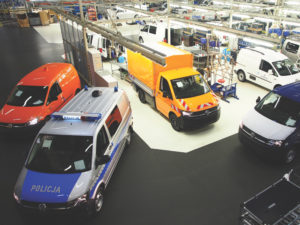Volkswagen Commercial Vehicles is planning growth in van conversions, specialist sales manager Nick Axtell tells Dan Gilkes.

There are very few light commercial vehicles that don’t undergo some form of conversion, from simple racking or additional lighting, to full body engineering. This is particularly true as vehicles get larger and heavier, with chassis cabs allowing converters to provide a wide variety of bodies, to complement the panel vans available from the manufacturer.
The majority of those van builders also offer a range of off-the-shelf conversions themselves, usually tippers, dropsides and Luton vans, to satisfy customers that want to buy a ready-bodied vehicle from a single source, under one warranty. Volkswagen Commercial Vehicles is no different in this respect, offering an Engineered-To-Go range that includes those three core models.
With the introduction of new Crafter this year though, VW is looking to build upon this base, with the creation of a business unit within the new Crafter plant in Wresznia, Poland, dedicated to conversion work. The company already has a similar operation at the Caddy plant in Poznan, where vehicles like those supplied to British Gas are liveried, have racking installed and are fully prepared for the customer before being shipped to the UK.
The new Crafter unit will initially build dropsides, in medium and long wheelbase and with single and double cabs. A tipper may also be offered, though as with the dropsides it will only be sold in the UK if the conversion suits UK customer demand, particularly with regard to weight.
“If it doesn’t work for the UK, we won’t take it,” said specialist sales manager Nick Axtell.
“Lutons we are definitely going to source locally. This doesn’t mean that we are not going to continue to help local converters, the customer needs choice and variety.”
The Luton conversion is currently being put out to tender among UK converters, who have also been asked to put forward other vehicle options that they might be able to provide, such as minibuses, refrigerated vehicles and welfare buses. These would be supplied under Volkswagen’s Engineered-For-You programme, rather than Engineered-To-Go.
Whichever programme you opt for, Volkswagen has been working hard behind the scenes to make the process easier for the customer, both at vehicle selection and purchase time, and in the event of repair or warranty work. All sales staff in VW’s Van Centres are now armed with an iPad loaded with sales information both for the VW product and for possible conversions. With this data to hand, salespeople can ask customers more informed questions, to build the perfect vehicle to meet their needs.
This is particularly important when specifying conversions. For instance, the device will suggest a range of factory options to suit a particular conversion, such as strengthened suspension packs, mirror arms that are long enough to see past a converted body, engine power take-off options and modified door hinges for fridge conversions.
“The Van Centre needs to be able to ask the customer the right questions,” said Axtell.
Any quote that is generated will automatically be sent to the converter, for up to date pricing and potential build times, allowing the sales person to provide the customer with a single source for their finished vehicle.

There are additional advantages to this new approach, some of which plug gaps in the VW system of the past. For instance a tail lift for a Luton van could not be put through VW’s system on the old Crafter, despite the fact that around 60% of Lutons were equipped with one. It would have had to be specified by the dealer, directly with the converter. That sort of addition is now covered within the VW ordering process.
There will also be a benefit to customers in terms of used values for some models. In the past if a chassis cab or panel van was imported and then converted in the UK separately, into a dropside or a minibus say, it would only be given a Cap code for the base vehicle, not for the conversion, so would not show the full residual value on the used market.
“We want to maximise the residual value for the customer,” said Axtell.
This approach extends to repair and warranty work too, with Volkswagen’s Van Centres now able to sign off repairs in their workshops to get the customer back on the road as quickly as possible, even if the job is conversion-related.
“The customer shouldn’t have to do the chasing, we should do the chasing,” said Axtell. “There needs to be ownership in our network.”
This new focus on conversions comes at an important time for Volkswagen, with new Crafter being phased in to replace the previous model throughout this year. As the new van is not a like-for-like replacement, but will be offered with a much broader range of drivelines and chassis possibilities, the company is hoping to greatly improve its share of this lucrative business.
With more than 50% of heavy vans undergoing some form of conversion work, aside from racking, Axtell admits that Volkswagen has only been capturing around 4% of the market with the previous model.
“For me, that needs to grow threefold at least,” he said. “It needs to justify the effort and deliver the returns. There has been a change within the company and within the Van Centres and it is core to our business.”

